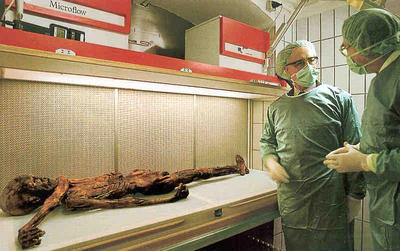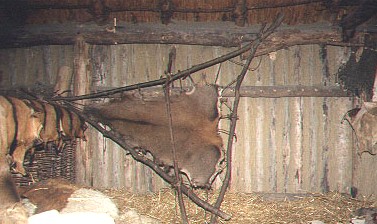Index Dutch Bronze Age
Index "First farmers in the Netherlands"
Deze bladzijde is ook in het Nederlands beschikbaar
Ötzi- overview
Ötzi, the glacier man
|
|
The Iceman's Last Mealby Brenda Fowler The Iceman did not die on a full stomach. Eight hours before his death on a barren Alpine pass, he was in the valley to the south, in what is today Italy's Schnals Valley. There, according to Dr. Klaus Oeggl, a botanist from the University of Innsbruck who recently examined his gut contents, the man took his last meal, not long before setting out on a hike from which he was never to return. The meal was a simple affair, consisting of a bit of unleavened bread made of einkorn wheat, one of the few domesticated grains used in the Iceman's part of the world at this time, some other plant, possibly an herb or other green, and meat. Oeggl reconstructed the Iceman's last meal from his microscopic analysis of a tiny sample removed from the mummy's transverse colon, the part of the intestine just beyond the stomach. When the Iceman was discovered in 1991, x-rays and CAT-scans of the corpse revealed that his internal organs had shrunken so drastically in the 5,300 years in the glacier that Dr. Dieter Zur Nedden, the radiologist who examined the images, could barely distinguish them. Instead of filling the chest cavity with their billowy white form, the lungs looked like wisps of clouds. But at the top of the colon, Zur Nedden made out a slight bulge, which the radiologist suspected was a clump of half-processed food. The progress of the food indicated that the Iceman had last eaten about eight hours before he died, possibly of hypothermia, on the Hauslabjoch pass, which cuts over the main Alpine ridge dividing Austria from Italy at 10,500 feet above sea level. Not until several years after the discovery did the Innsbruck scientists finally cut a hole into the mummy, insert an endoscope, and snip out about .004 ounces from the colon. Dr. Werner Platzer, the University of Innsbruck anatomist then in charge of research on the corpse, gave .0016 ounces milligrams of the material to Oeggl, who had already been studying the rich botanical finds from the site. Oeggl's sample was barely the size of his little fingernail. Under the microscope, he quickly identified the flake-like, semi-digested material that made up the bulk of the sample as einkorn, the most important wheat of the Neolithic, the period of prehistory in which people lived in semi-permanent settlements and survived by agriculture and keeping animals. The discovery of einkorn, which does not occur naturally in Europe, in the Iceman's intestinal tract suggested that he had contact with an agricultural community. The dominance of bran in the sample led Oeggl to believe that the wheat had been finely ground into meal and made into bread, rather than eaten as a porridge, where the grains would have been eaten whole and found in larger pieces in the colon. But the bread would have been little like modern breads. In order to get bread to rise when yeast is added, the wheat grains must contain a high level of gluten, which lends the dough a durable elasticity and therefore holds the pockets of air. Einkorn has low levels of gluten, so the bread made with it was probably hard, somewhat like a cracker, and rather tough on the teeth. Wheat spiklets derived from Einkorn grain, Using an electron microscope Oeggl also spotted tiny particles of charcoal attached to the bran, probably remnants of the baking process on a hot rock, in a bread-oven or next to a fire. In addition to the einkorn, the cells of at least one other plant, possibly some herb, were present in the sample, and Oeggl concluded that they, too, had been part of his meal. He also found a tiny muscle fiber and a burned bit of bone, evidence that the Iceman might also have eaten a meat. What kind of meat Oeggl cannot yet say, nor can he determine how much of the meal the sample represented. Not everything passing through the Iceman's gut had been swallowed intentionally, or was even desirable. Oeggl also found the eggs of the human whipworm. Many people alive today who do not live in areas with flush toilets also carry the worm, which can cause unpleasant symptoms like stomach ache and diarrhea, or even lead to malnutrition. The scientists have no way of knowing whether the Iceman had any such complaints. The sample also contained many different varieties of pollen, whose strange and beautiful forms Oeggl saw under the electron microscope. Though some peoples are known to eat pollen, Oeggl believed that the quantity in his colon was too small to represent a meal. Instead, the pollen accidentally ended up in the man's stomach because they either had landed in food or water he ingested, or were inhaled and became trapped in saliva which he then swallowed. Where did he come from? The majority of the pollen came from the hop hornbeam tree (Ostrya carpinifolia), which grows in a warm environment. As soon as Oeggl recognized it under his microscope lens, he not only knew which side of the mountain the Iceman had been on shortly before his death, but also the season in which he died. The hop hornbeam tree blooms between March and June, and because the sperm inside the pollen grain, which normally decays after a short exposure to air or water, was still intact, Oeggl believed it had to have been absorbed relatively soon after its release from the tree. The nearest stands of that tree could have grown to the south of the Hauslabjoch, at least five or six hours away by foot. The high valleys to the north are just too cold to sustain it. The pollen of this particular tree was, therefore, one key to understanding the Iceman's last hours. It meant that the Iceman was almost certainly in the valley within half a day of his death. Previously scientists had speculated that the Iceman had died in the late summer, when he was surprised by an early storm while trying to cross the pass. Oeggl readily acknowledges that scientists may never know what prompted the Iceman to leave the relatively hospitable valley with no water or food to speak of (a single sloe berry was found with his remains) and try to cross the mountain at a time of year when several feet of snow easily could have obscured the topography of the steep and rocky Alpine ridge. But his own interest in the Iceman's demise is not yet exhausted. He expects that his meticulous analysis of the botanical and archaeological material recovered from the bottom of the shallow in which the man died will soon reveal more details about the circumstances of the Iceman's death.
His back-pack Ötzis last meal: red dear and capricorn with beans?September 2002 Ötzi ate red dear or capricorn. He also ate cereals and other plants, possibly beans. This information comes from a genetical analysis of his intestines. This discovery also supports the theory that he became the victim of a battle between hunters. There have been many theories about Ötzis life since his body had been found. He should have been a lonely hermit who died of malnutricion. Or he was a shepherd who followed his lost animals and who got lost himself. Last year scientists finally discovered an arrowhead in his left shoulder, that was shot from his behind. If he didn't died immediately, then he only lived a mere 24 hours. But that raises the next question. Was he shot in battle or ritually sacrificed? Italian reasearchers of the University of Camerino now think they know it had been a battle. They concluded this from the food that they found in his intestines two years ago. The Italians tried to retrieve some DNA from those traces, to discover what he had been eating during his last meal.
The researchers also discovered pollen of various plants, which simply fell of bushes and landed on his meal. He ate them without noting it. These traces can tell us more about his last whereabouts, or at least where he ate. Hophornbeam (Ostrya carpinifolia) only appeared halfway up the mountain, just below the tree borders. The scientists believe he ate his meal in a forest of hazel-trees, birch and hophornbeam. Where he exactly ate it can't be told by the pollen. But his stomach was empty, and the place in the intestines where the remains of the meal were located can be reached in 3 hours after his last meal. So if Ötzi ate before he was attacked, then his death-struggle lasted three hours. But the researchers know they speculate. Because the speed in which the intestines process the food depends on ones mood. Sudden stress slows downs the food-processing. It is unlikely that his intestines were still working after he was hit. Therefore it is also possible that he was hit three hours after his last bite. Photo
right: a dear's skin. The fur with the long hairs feels very warm, even when it's
freezing. But the examination of the food supported some theories about Ötzi. Red dear and capricorn weren't common food for the people of his time. They mostley ate small animals like squirrels, rabbits and rats. So Ötzi was probably a hunter who shot his own meal - his bow and arrow also point in that direction. It is also known that hunters aimed for the left shoulder of their game, because that enlarged the chance that the prey was killed instantly. "To us, it appears most likely that Ötzi became the victim of a fight between hunters and not a ritual sacrifice because of the arrow in his left shoulder". This theory also explains why he was found on an altitude of over 3200 m. Maybe the fight started when he was stil halfway the mountain, where he also ate his capricorn. Hit by the arrow he fled for the other hunters, who didn't follow him on his way up. He died shortly after he arrived on his last resting place, resting on his left arm. Marc Koenen F. Rollo et. al.: Ötzi’s last meals: DNA analysis of the intestinal content of the Neolithic glacier mummy from the Alps. In: Proceedings of the National Academy of Sciences (PNAS), internetpublication doi/10.1073/pnas.192184599 (16 september 2002).
|



 They
succeeded only partially, as can be viewed in the magazine
They
succeeded only partially, as can be viewed in the magazine 

